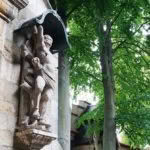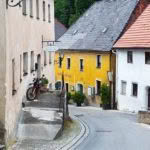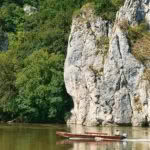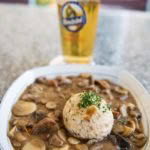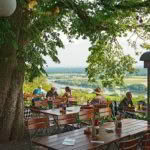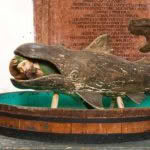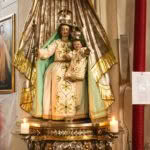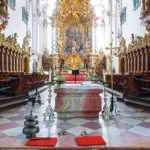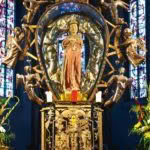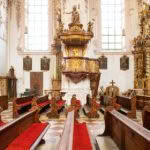Don Fuchs explores Lower Bavaria’s breathtaking monasteries and churches

Kloster Weltenburg on the banks of the Danube.
In the monasteries and churches of lower Bavaria, spiritual and secular pleasures go hand in hand.
Words and Photos: Don Fuchs
The child was a little over one year old when she died on a cold January day in 1319. And yet she is still with us. I enter a vestibule cloaked in darkness and the lights, triggered by a movement detector, come on to reveal a vaulted ceiling held up by a central pillar and a glass vitrine inside an ornate cabinet. Inside is the mottled, mummified body of the child.
Her legs are crossed like Christ on the cross; a simple white cloth is draped over her genitals. Her head looks too big for her shrunken body, her mouth slightly agape: Meet Princess Anna, daughter of Emperor Louis IV. Her last, and rather public resting place, is the vestibule of the church at the Kastl Abbey, a majestic monastery on top of a steep hill, high above the picturesque village of Kastl in Lower Bavaria. Kastl, hidden in wooded hills, is in one of the seven administrative regions of the German state of Bavaria. It represents not only the most conservative part of Bavaria but also of the whole of Germany. Here, tradition and religion define life.
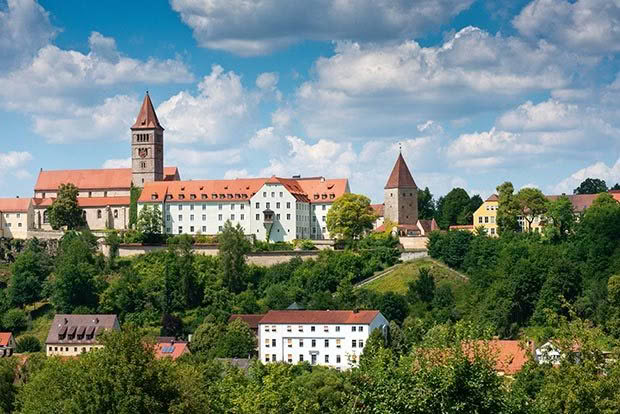
Kastl Abbey is thought to have been founded in 1103.
Throughout Lower Bavaria’s peaceful rural scenery are monasteries and churches, cultural and architectural monuments full of artistic masterpieces. Many of the monasteries are no longer in the hands of nuns and monks. During the secularization of 1802–1803, monastic lands and buildings were seized by the state or sold. Bavaria became a secular state and many monasteries, although still referred to as such, nowadays house schools, businesses or even luxurious holiday accommodation. But don’t be fooled, despite the secularization, the Catholic church is still powerful and essential to society.
It is July, the height of summer. I’m near the top of the 432-metre Bogenberg (hill) from which the view extends over the lowlands, a mosaic of golden and green fields ripe with the promise of a heavy yield. Infinity is obscured by summer haze. Deep below flows the Danube, framed by a thin strip of trees on either side. Barges and riverboats slowly cruise by. I have a front-row seat for this peaceful panorama – under the shade of a chestnut tree in a beer garden that belongs to a gasthaus aptly called Zur schönen Aussicht (beautiful view). In front of me is a glass of golden chilled beer and a menu promising tasty Bavarian specialities.
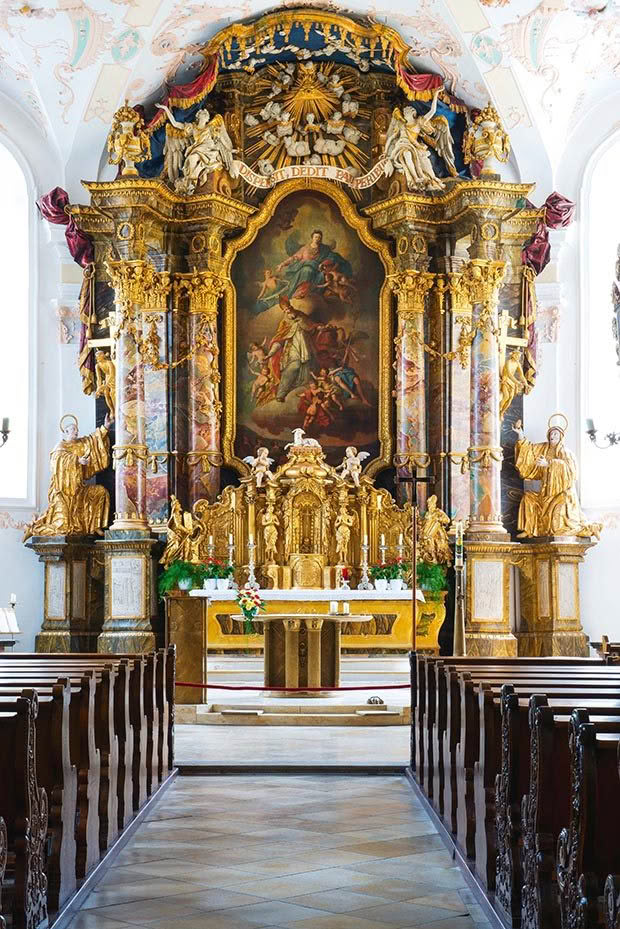
The ornate altar at the Waldersbach Abbey.
A couple of minutes’ walk from this peaceful culinary and secular enclave, in a commanding position on the highest point, is a church. The famous Sanctuary of the Assumption is considered the oldest pilgrimage church in Bavaria and the Bogenberg itself is often called the Holy Mountain of Lower Bavaria.
After devouring weisswurst with a pretzel and sweet mustard, I walk to the church. While admiring the rare stone figure of a pregnant Mary (early 15th century) the organ suddenly begins to bellow. The organist obviously thinks he is alone and launches into a soaring piece. It is powerful and mesmerizing. A young couple – locals – saunter in on their evening walk and stay a while to listen before heading out again, joining the other locals in the beer garden.
It is not a coincidence that a gasthaus is near the church. There is a close symbiosis between secular and divine institutions in Bavaria. Many monasteries have a so-called klosterwirtschaft, an inn or tavern, within their ancient walls, and quite a few brew their own beer. The famous Benedictine Abbey of Weltenburg is one, although it’s a great contrast to the idyllic Bogenberg.
The car park is full. The walk to the monastery is crowded with tourists. From the village of Weltenburg, a small farm road leads up to the Frauenberg, a hill high above the Danube. Framed by forest and freshly cut meadows, the walk passes the stone foundation of a Roman fort before descending towards the river. The afternoon sun is still powerful, and there is a heady scent of green grass and pine in the air. After a steep descent by stone steps, I enter the abbey’s grounds and encounter a maelstrom of people, including tour guides herding customers.
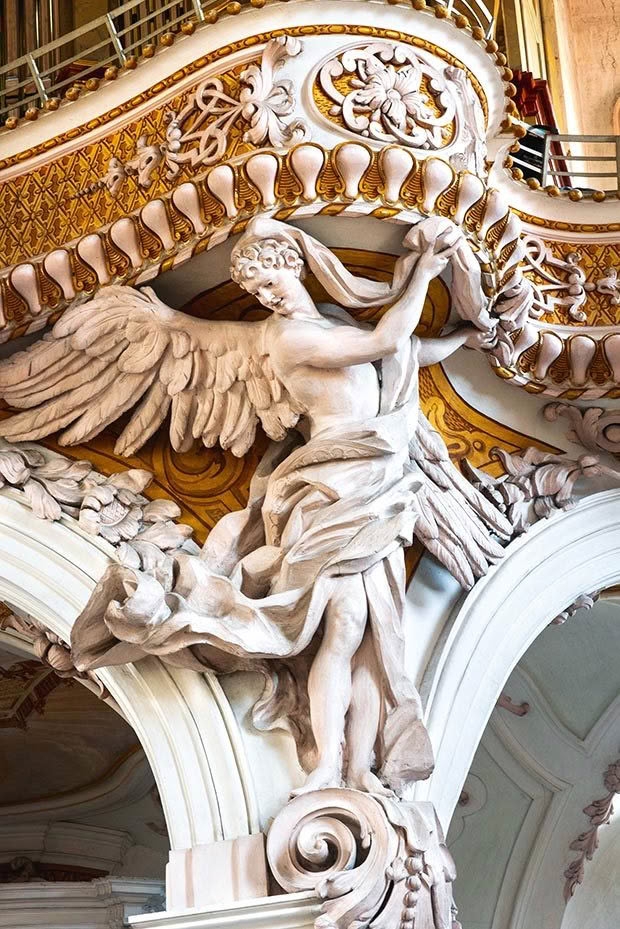
The churches associated with Lower Bavaria’s monasteries are packed with opulent decorations, architectural marvels, intricate details and Catholic symbolism.
This famous baroque church, built by architect brothers Cosmas Damian and Aegid Quirin Asam, is rather inconspicuous on the exterior. But that belies its opulent interior. It is quite small for a Bavarian monastery and yet, once inside, one cannot help but marvel. Marble columns, gold-lustred stucco, wall frescos and, 20 metres above the floor, floats the ceiling’s elaborate fresco. The brothers are noted for creating sacred spaces in which painting, sculpture, light and expanse become, within the architectural framework, a unified work of art.
On the main altar Saint George slays the dragon, and with the power of the image and its details, conversations dim to a whisper. It is an international crowd with many coming from river cruisers on the Danube (in which the abbey features prominently as an outing). The “no photography” signs are largely ignored by owners of smartphones.
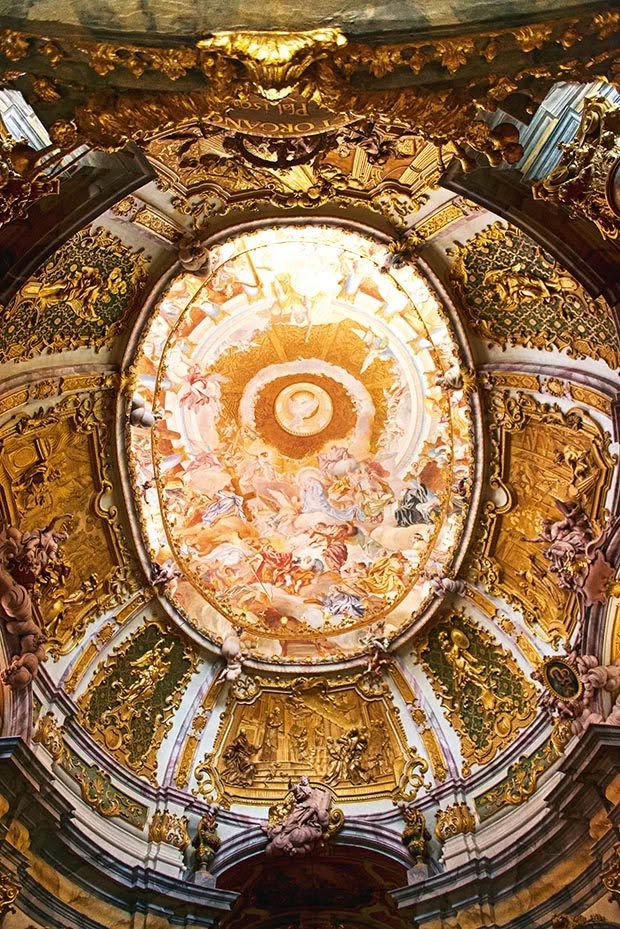
This Benedictine abbey, Weltenburg, is the oldest monastery in Bavaria and was founded in about 600AD. It is built on a river bend backed by steep forested hills. Just a few minutes walk downriver is the entrance to the scenic Danube Gorge, with its dramatic, 80-metre limestone cliffs. But the real highlight for many pilgrims here is beer. The monks have been at it for a very long time – the Klosterbrauerei is considered the oldest brewery in the world, going back to the year 1050. The beer garden, just a few cobblestoned metres opposite the church, bursts at its seams. Patrons sit at simple wooden tables with folding chairs. The traditional beer garden tree, the chestnut with its large leaves, provides shade.
- Sculpture at St Emmeram.
- The ancient town of Kastl below Kastl Abbey.
- An impressive limestone gorge carved by the Danube near the monastery of Weltenburg.
Waiters and waitresses are dressed in blue and white, the traditional Bavarian colours, and carry beer in large steins and Bavarian meals. Today’s special is beef goulash with dumplings and a side salad. There is a happy buzz, but for me, the restless, noisy masses give the place a slight Disney feel and trigger my flight instincts. I get ferried across the river in one of the many zillen, small traditional boats used on the Danube, several of which are sitting on the gravel banks in front of the abbey. Once on the other side, walking trails lead into a different world of cool beech forests and lofty lookouts from limestone cliff tops. Golden afternoon light filters through the canopy and there is an intense, earthy smell of mushrooms.
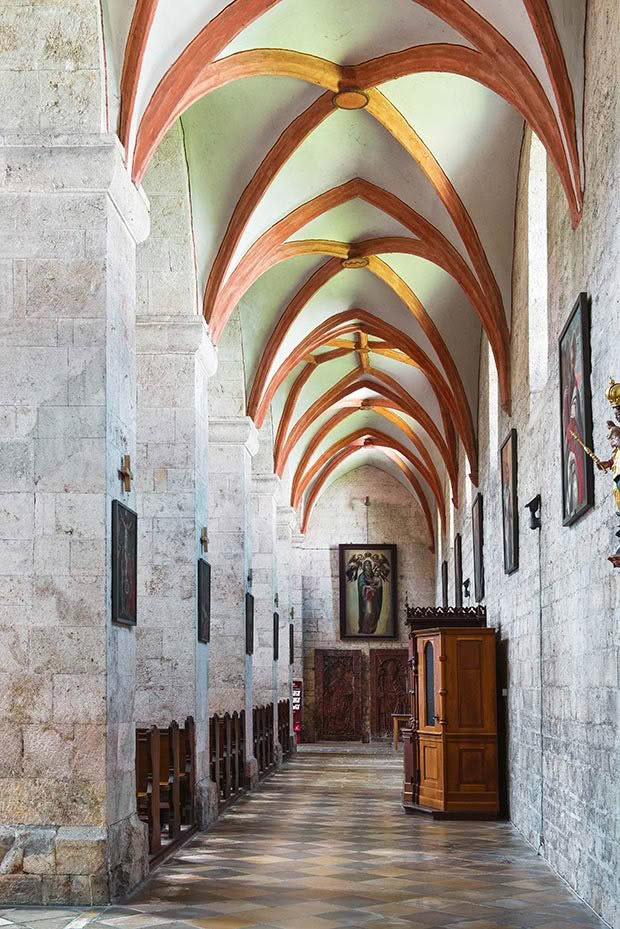
Weltenburg is not the only monastery where I encounter big crowds. At Aldersbach Abbey, a former Cistercian monastery, it is hard to come by a park. Rangers are on the prowl, ready to slap a ticket under your windscreen wipers if you dare to disobey the signs. The reason for this rush, however, is not to do with tourism; as far as famous Lower Bavarian monasteries go, Aldersbach is one of the more obscure. The reason for the crowds is a country fair of local products and businesses within the monastery grounds.
One of the most prominent businesses in the area is right here: the Brauerei Aldersbach, a brewery going back to the year 1268. For the small fee of two euros, visitors can take a self-guided tour through the quite modern brewery with its shiny steel tanks, antiseptic cleanliness and computers forming a contrast with the old walls that house them.

In the Bräustüberl, with its low arched and whitewashed roof, visitors are busy sampling the brewery’s quaffable products. It would be a real shame, however, if they were to neglect a visit to the church next door with its extraordinary wood carving depicting a whale about to spit out the prophet Jonas. With no crowds, no brewery, no tavern, the Biburg Abbey is as obscure as it gets. And yet the drive along winding country roads, through golden cereal fields, forest enclaves and rolling hills is worth it. It is one of the few destinations on this trip purely reserved for all things sacral.
The former convent of Benedictine monks in the sleepy village of Biburg contains a church that has remained virtually unchanged in its structure and integrity since inauguration in 1140. It is one of the most important Romanesque monuments and one of the oldest surviving churches in Bavaria.
The contrast to the usually opulent baroque Bavarian churches couldn’t be more marked. The church Maria Immaculata, with its two plain steeples, is almost austere and the sense of age is overpowering. Built from pale limestone and tufa, it is laid out in the form of a cross. Despite its rigid simplicity, there are many fascinating details – the medieval stone relief of Christ above the portal and the symbolized depictions of several of the seven deadly sins among them.

Following Biburg, I head for the monastery in Waldersbach, a former abbey with a fascinating, essentially Romanesque church and Rococo spire and plenty of pleasures of the flesh. This time, however, culinary tastes come before cultural or spiritual. The Gasthof Rückerl within the monastic buildings beckons the hungry. A blackboard of the day’s specials shows a dish very much to my liking: bread dumplings – a Bavarian staple – with wild mushrooms. July marks the beginning of the mushroom season in Lower Bavaria, and the chance to taste fresh porcini and chanterelles is too much temptation.
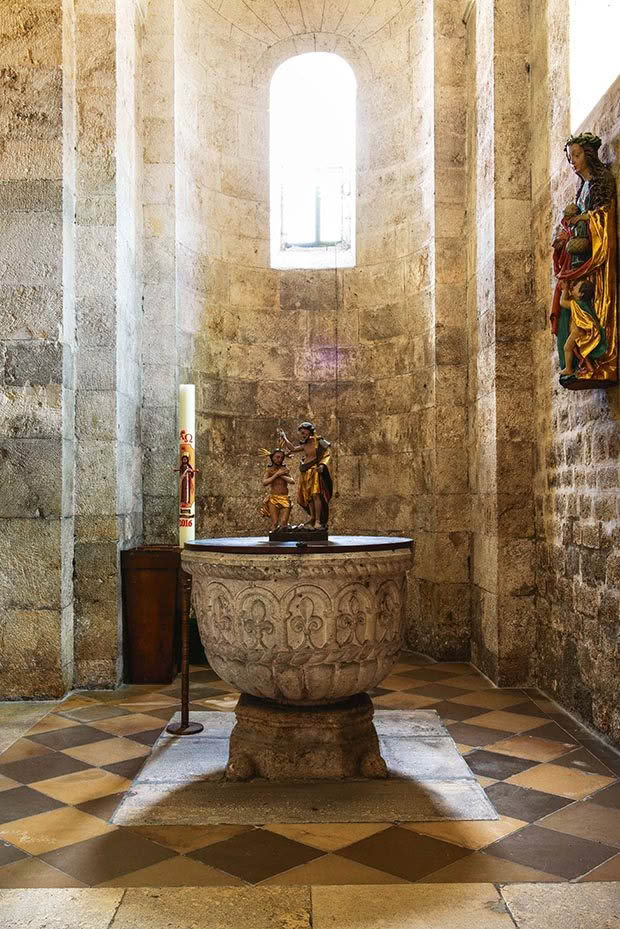
The baptismal font in Biburg Abbey.
Many of the monastery gasthauses are quite well known for the quality of their food. That is the reputation of the restaurant and the tiny walled beer garden at Kloster Ansbach. One of its specialities is a very traditional dish: sauerbraten mit apfelblaukraut und gebratenen serviettenknödel (beef marinated in vinegar, peppercorns, garlic, onions, and bay leaves, served with red cabbage cooked with apples and – of course – dumplings). It is heavy fare, best accompanied by local beer and followed by exercise.
But not all the restaurants attached to monasteries stick to traditions. At the monastery of Pielenhofen, sitting on the back terrace watching young locals cooling off in the river Naab, I enjoy an authentic-tasting pizza.
Then it is time to head for the big smoke (comparably) – the beautiful city of Regensburg. There are many reasons to visit. One of them is St Emmeram. Now owned by Bavarian royalty – the Thurn und Taxis dynasty – the former Benedictine monastery is also known as the Thurn und Taxis Schloss (castle). A visit to the ancient St Rupert Church and basilica seems the perfect way to round off my exploration of Lower Bavaria.
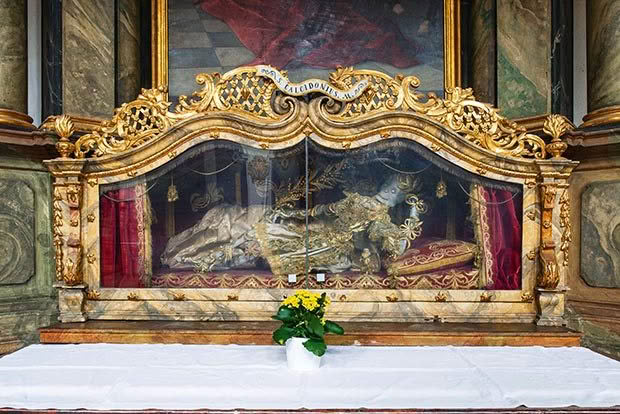
The remains of St Maximianus at St Emmeram in the town of Regensburg.
Access to the church, built in 780, is through a shady courtyard that shields the church from the surrounding everyday life. Inside, the middle nave and apse with the high altar again bear the signature of the Assam brothers who, between 1731 and 1733, redesigned the interior of the church in the baroque style. The dim light, the old tombstones, the bones in glass shrines – all give this church a sombre atmosphere.
Emerging out of the dark church into daylight feels as if all my past and future sins – mainly gluttony I’m afraid – are now forgiven. Then it is high time to head for the closest gasthof.
- Bread dumplings with a creamy sauce of wild mushrooms are a seasonal dish at the Waldersbach Monastery.
- The beer garden at Bogenberg with views to the Danube.
- Woodcarving of the whale spitting out Jonas at the Aldersbach Monastery.
NOTEBOOK
How to get there: International flight to Munich, car rental at the airport, then drive to Lower Bavaria (one and a half hours). A car is essential to explore the region. Purchase a good map as some of the more obscure monasteries are not listed on the GPS.
Where to stay: Klosterhof St Salvator, Bad Griesbach offers stylish and well-appointed holiday apartments within the old monastery. klosterhof-st-salvator.de
Every town and village in the region has affordable rooms in little pensions (B&Bs) or gasthäuser (traditional inns).
When to go: June and July, the European early summer, is seductive. August is usually busy as it is school holidays. September and October – with their stable weather – are also ideal, especially for walking. This is also the harvest season in Lower Bavaria.
More to see: Besides the mentioned monasteries, the impressive ruin of the church at the former monastery of Gnadenberg, the opulent baroque church of Rohr Abbey, and the abbeys of Frauenzell, Metten, Niederalteich, Plankstetten and Fürstenzell are all well worth a visit. Also consider Kloster Mallersdorf, a small brewery run by nuns.
More information: bavaria.by
Love this story? Subscribe now!
 This article first appeared in NZ Life & Leisure Magazine.
This article first appeared in NZ Life & Leisure Magazine.
